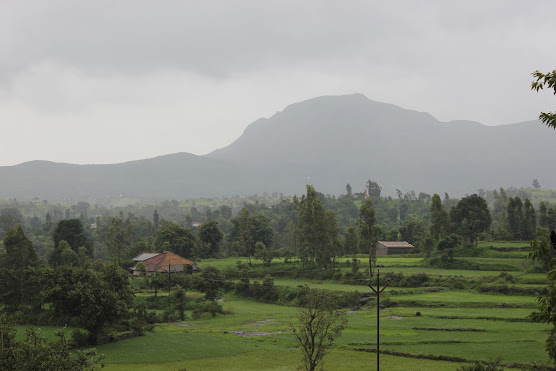About
Ratangad is a fort in Ratan Wadi, Maharashtra, India, overlooking the locale of Bhandardara, one of the oldest artificial catchment area. The fort is about 2000 years old.Ratangad has a natural rock peak with a cavity in it at the top which is called 'Nedhe' or 'Eye of the Needle'.
Ratangad was captured by Chhatrapati Shivaji Raje Bhosle and was one of his favorites. The base village Ratanwadi has an Amruteshwar temple which is famous for its carvings. The fort is origin for the river Pravara/Amrutvahini. The Bhandardara dam(arthar dam) is built on this river.
The main attraction at Ratanwadi is the Amruteshwar temple dating back to the Hemadpant Era - roughly from the eighth century.
The base village Ratanwadi is approached by boat from Bhandardara. By boat, it is a 6 km journey and further it is a 4 km walk till Ratanwadi
'Nedhe' s hole in the sheer rock face due to constant erosion is a major attraction atop Ratangad fort offering splendid view of the valley and surrounding hills.


What i liked about Ratangad Trek was its unique approach. You need to take a ferry over the Arthur Lake to get to the base camp. A series of waterfalls and a thick jungle follow next. Finally the entrance to the Fort is well hidden and you need to enter it from a chimney!
The base camp for Ratangad is at Ratanwadi Village. The village is separated from Bhandardhara by Arthur Lake. Bhandardhara can be reached from Igatpuri via Ghoti village. Igatpuri is the nearest railway station from where road transport is available all the way to Bhandardhara. From Bhandardhara ferries are available to reach Ratanwadi. There is a much longer road route also available from Bhandardhara to Ratanwadi but it is in very bad condition.
Temple at base
The Amruteshwar Temple in Ratanwadi is more than a 1000 years old. Lord Shiva is the main deity in this temple. Legend in fact says it was built by the Pandavas during the Mahabharata period. Amruteshwar Temple is built in Hemadpanthi style of architecture. This style uses black stone and lime in the construction and was propagated by Hemadpanth, the prime minister in the court of Seuna Yadavas of Devagiri. The Amruteshwar Temple has several carvings worth having a look. During Rainy season even the inner sanctum gets filled with water.
The Trek up
The trail to Ratangad starts right after the temple. The first stretch is full of paddy fields. You will cross the Pravara River several times as it cuts the Trail. Soon the gradient changes and the ascent starts. After an hour of brisk walk you will enter a thick jungle. Towards the other end of the jungle are 2 ladders out up by good Samaritans. These ladders help in crossing the steep boulders. However one needs to exercise utmost aution on the ladder during the rains as it can get very slippery. Sometime bare feet give you the best grip better than any shoe. Usually the trek from base camp to the Fort takes 3- 3.5 hours.
The Fort
Once you have crossed the second ladder a small adventure awaits you. The entrance to the Fort is from a Chimney! There are 2 grand gates to cross- Ganesh Darwaza and Hanuman Darwaza, before you can get some rest in the 2 caves located on top.


Further from the Caves is a third entrance called Chor Darwaza or the door of the thieves! It was a secret entrance but is caved in today. Kalyan Darwaza is the 4th Entrance to the Fort and the least known of the lot. There are as many as twelve fresh water tanks on top of Ratanwadi Fort. On the eastern side of the Fort, there is some fortification in the form of bastions and stone walls left. The Rani Mahal or the Queen’s Chambers is located here.
Eye of the Needle
The “Nedhe” or Eye of the Needle is a hole in the Rock formed by Wind Erosion. It is a magnificent sight even from the base camp. You get a sense of achievement to sit inside the orifice after a 3 hour trek as you experience the howling wind. The Eye is pretty large and can accommodate 6-7 people at a time. The Eye of the Needle is both literally and figuratively the high point of the Ratangad Trek as you relax and lord over all that is below you!
Stay Options
MTDC has cottages in Bhandardhara. These are picturesquely located facing the Arthur Lake. A more adventurous option is to stay overnight in the Cave on top of Ratangad Fort!
Best Route from Mumbai to Ratangad
Mumbai - Kalyan - Asangao - Sakurli - Ghatgar -Bhandardara - ratanwadi - Ratangad
Pune - Nasik Phata - Narayangao - Otur - Bhramanwada - Kotul - Rajur - Bhandardara - Ratanwadi - Ratangad
Pune to Ratangad : 180 KM
Mumbai to Ratangad : 140 KM
Kolhapur to Ratangad : 400 KM
Nasik to Ratangad : 100 KM
Nagpur to Ratangad : 775 KM
B'lore to Ratangad : 1000 KM












